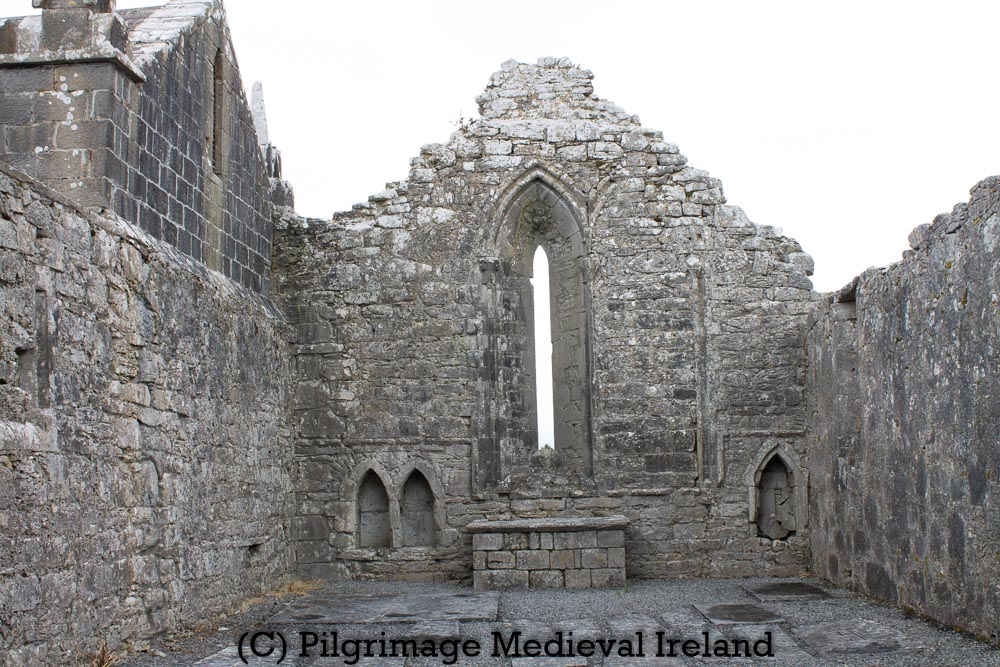St Sourney (Sairnait in Irish), is the patron saint of the holy well and medieval church at Drumacoo, Co Galway (Gwynn and Hadcock 1970, 34). Sourney was a holy woman who lived in Ireland during the sixth century, little is known about her life. She is also the patron of the small early medieval church of Teampall Asurnaí (St Sourney’s Church) at the village of Eochaill on Inismore. Tradition holds she also founded a monastery at Drumcoo during lifetime. Her feast day was celebrated on the 3rd May.
The schools collection for Ballinderreen, Co. Galway record an interesting folk tale relating to the saint.
Saint Surney sent one of her servants to Island Eddy for a coal, the servant went and she got the coal from the woman of the house who put it into her pinafore and as she was coming home the coal burned ahole in her pinafore. The saint was vexed when she saw the hole and she cursed Island Eddy and she said that anyone would come from island Eddy to Arran with a dry feet and the sea came between Island Eddy and Arran and the people never come out without a boat. Saint Surney was a very holy woman and she never cursed until she cursed Island Eddy. A little girl always stayed with the saint till after her death. The saint used to pray for hours every day and every one knew she was a saint because she used to pray very often.
The Schools’ Collection, Volume 0033B, Page 03_004
The modern visitor to Drumcoo will find a multi-period church surrounded by a later historic graveyard.

The oldest part of Drumcoo church can be seen in the north wall and the west gable. The style of masonry and the flat lintel doorway (trabeate doorway) suggest the presence of a simple pre-Romanesque style stone church that was later modified.


The southern wall is later and dates to around the mid thirteenth century. This wall has a very fine pointed doorway with intricately carved features including the heads of a number of cats. The door is the work of a very skilled crafts person.
The beautiful S. door is one of the minor masterpieces of the Connacht Transitional style and seems, like the E. windows, to be the work of the Boyle-Cong-Knockmoy-Corcomroe school of masons.
(Killanin & Duigan 1967, 318).








The east gable of the church has two fine carved single-light windows, one of which was blocked up. On either side of the windows are finely carved pointed aumbry.

A large and striking mausoleum built in 1830, is attached to the north eastern end of the church. The mausoleum was built to house the bodies of Arthur and Harriet St George.
The earliest recorded evidence of pilgrimage at Drumcoo dates to the nineteenth century, but its likely the tradition of pilgrimage was much older.
The 1st edition Ordnance Survey map shows an extensive pilgrim landscape surrounds the church, a holy bush, a saints bed and the holy well, all were dedicated to St Sourney.

The contemporary Ordnance Survey Letters Co Galway (1838) also records these religious stations.
Sórnach [Sourney] whose Bed (Leabaidh), bush (tseach) and well (tobar) are shewn in the townland of Drumacoo.
(Herity 2009, 75)
St Sourney’s bush does not appear on later ordnance survey maps suggesting devotions and local interest in the tree ceased after this time.
St Sourney’s bed was described in 1890 as
one of those stone cells in which many of our early Saints loved to do penance. It measures about 6 feet [1.83m] in length by 4 [1.22m] in width externally.
(Fahey 1893, 33)
In 1980’s the bed was described as
completely ivy-covered and consisted of a rectangular mass of stone (L 2.6m; Wth 2m; H 1.7m) aligned N-S. According to local information, it was subsequently destroyed during a graveyard clean-up.
Galway Archaeological Survey, UCG
Only St Sourney’s holy well has survived, although it was rebuilt in the 1980’s using stones from St Sourney’s bed.
The well was recently rebuilt by a work crew who unfortunately took the stones to build it from what was reputedly St. Sairnait’s cell or ‘bed’
https://www.visitgalway.ie/explore/religious-and-spiritual/holy-wells/st-sourneys-well/
The holy well is located a short distance to the southwest of the medieval church. The well is enclosed by a circular stone wall.

A gap in the wall provided access into a circular area covered by gravel. The holy well sits at the centre, below ground level. Stone steps provide access to the stone lined interior of the well. When I visited the well it was dry.

Its was said that the wells water was an effective cure for a pain in the head. In the 1930’s those in search of healing would visit the holy well and devotions performed on two consecutive Mondays and the intervening Thursday.
If a person is subject to a constant headache he goes to this well for a cure. He goes to the well three times, on Monday,Thursday and the following Monday. Every time he visits the well he should leave something, if only a button, on a bank of earth which is raised beside the well.
The Schools’ Collection, Volume 0033B, Page 01_047
He says certain prayers at the well, then he brings a bottle of water from the well and washes his forehead with it every day.

Bibliography
Fahey, J.A. 1893 (Reprint 1986) The history and antiquities of the diocese of Kilmacduagh. Galway. Kenny Gallery.
Galway Archaeological Survey, UCG. Church GA103-118001, https://maps.archaeology.ie/HistoricEnvironment/
Higgins, J.G. 1987 The Early Christian cross slabs, pillar stones and related monuments of County Galway, Ireland, 2 vols. British Archaeological Reports, International Series 375. Oxford.
Herity, M. 2009. Ordnance Survey Letters Galway. Dublin: Fourmasters Press
Killanin, M.M. and Duignan, M.V. 1967 (2nd ed.) The Shell guide to Ireland. London. The Ebury Press.
Harbison, P. 1970 (Reprint 1992) Guide to the national monuments in the Republic of Ireland. Dublin. Gill and Macmillan.
http://www.visitgalway.ie/explore/religious-and-spiritual/holy-wells/st-sourneys-well/